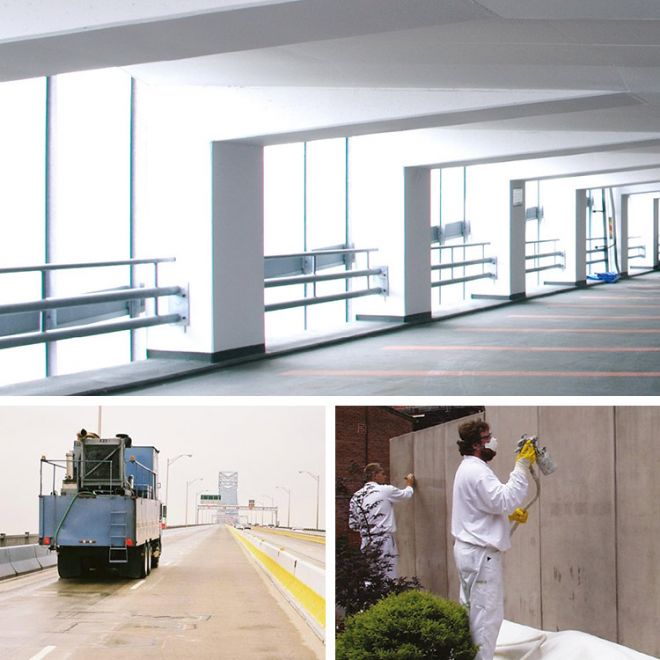Corrosion inhibition
Steel-reinforced concrete structures represent major private and public investments. Over time, however, reinforcing steel can corrode and rust, leading to a weakening of the structure if expensive repairs are not undertaken. The key to successful protection of valuable building structures is to stop water and chloride ions from entering the substrate. If the structure is already experiencing corrosion, there is still a viable cost effective solution.
Protectosil® CIT is an advanced silane based corrosion inhibitor system with outstanding features. Like other Protectosil® products, Protectosil® CIT builds a deep and long-lasting barrier because it penetrates into the substrate and binds chemically to the concrete. It protects steel-reinforced concrete by interrupting the corrosion mechanism. Even in concrete exposed to high corrosion conditions, Protectosil® CIT has proven its efficiency.
The best repair is one which does not have to be done. This is why we recommend using Protectosil® CIT.
Advantages at a glance
- Dramatically reduces the chloride induced corrosion of steel concrete reinforcement via reaction of active material with the cement phase and the steel surface
- Repassivates steel rebars after chloride induced corrosion
- Meets the requirements of EN 1504-2
- Is highly reactive and resistant to alkaline environment
- Forms colourless and water vapour permeable impregnation
- High reduction of water uptake and of chloride uptake
- Is applied undiluted to a concrete surface and is absorbed quickly
- Penetrates deeply into the concrete
- Is suited for old and new structures
- Is suited for every type of steel reinforced concrete
- Is effective in marine environments with high relative humidity and areas where de-icing salts are used such as car parks, jetties, piers, decks, facades, balconies, walkways, bridge decks, beams, columns
- Effectively inhibits macrocell (mat-to-mat) and microcell (along rebar) corrosion of steel-reinforced concrete
- Reduces corrosion in carbonated concrete steel-reinforced structures
- Equalises the differences in electrochemical potential between polymer concrete and existing concrete when applied to concrete structures repaired with polymer concrete
- Can be used according to principles 1, 2, 8 and 11 of EN 1504-9

Interrupt the corrosion mechanism
Water entering into building substrates is one of the most significant causes of damage. In challenging weather conditions, this may result in freeze-thaw or salt burst. But water is only one reason for damaged steel-reinforced concrete.
The real cause of corrosion on steel-reinforcement bars and the consequent mechanical stress is chloride induced corrosion. Water molecules bind electrostatically to concrete, forming the conductive medium for the chloride induced corrosion process that dissolves the rebar.
Protectosil® CIT efficiently counteracts both mechanisms. First, Protectosil® CIT provides a deep barrier that blocks water, and thus chloride ions, from reaching the rebar. Second, Protectosil® CIT’s organofunctional chemistry interrupts the electrolytic current, causing a substantial reduction in corrosion current and the by-product rust. An independent study has proved that three other commercial corrosion inhibitors “did not show any benefit in inhibiting the corrosion of chloride contaminated reinforced steel“* while “Protectosil® CIT by Evonik effectively reduced corrosion under the conditions of the ASTM G-109 procedure.“**
How Protectosil® CIT works
Prevent corrosion
WJE Associates* carried out tests on steel-reinforced concrete slabs in accordance with methods of the US Federal Highway Administration. Some of the slabs were coated with about 600g/m² of Protectosil® CIT, whereas other specimens were exposed to a cyclic saltwater (15 wt% NaCl solution) ponding test without any protection. Corrosion current, the resistance and half-cell potentials were measured. The ponding test of an unprotected specimen showed active corrosion after 250 days, which is indicated by a very high macrocell corrosion current.
The formerly unprotected specimens were dried after the 250 day test and Protectosil® CIT was applied. After one week of curing, the ponding test was continued. With Protectosil® CIT, the corrosion current in the formerly unprotected specimen decreased by 90%.
Effective in cracked concrete
WJE Associates* carried out tests on concrete slabs with cracks of 0.3 mm width right above the steel-reinforcement. Some of the concrete specimens were treated with Protectosil® CIT before wetting-drying cycles with a 15 wt% NaCl solution were performed. Other specimens remained unprotected.
After 12 weeks of testing the untreated samples clearly showed signs of rust, indicating active corrosion. By contrast, the Protectosil® CIT treated specimens did not show any signs of active corrosion.
Chloride ion content or corrosion currents clearly indicate the risk of rebar corrosion
It is important to identify the risk of rebar corrosion before substantial damage occurs to the concrete. One of the most common methods for identifying corrosion is to determine either the chloride ion content or electrical potential/voltage differences. Convenient for on-site corrosion detection are corrosion measurements, for example, with linear polarization equipment.
Technical data
| Properties and test methods | Value | Unit | Method |
|---|---|---|---|
| Colour | Clear to slightly amber | - | - |
| Density | 0.882 | g/cm3 | DIN 51757 |
| Viscosity (20°C) | 0.95 | mPa's | - |
| pH | 11 | - | - |
Registration
EINECS/ELINCS (EU)
Application details
| Substrate | Application rate |
|---|---|
| Concrete (above water level) | 2-3 coats 180-230 g/m² each |
| Concrete (in tidal or splash zone) | 5-6 coats 180-230 g/m² each |
